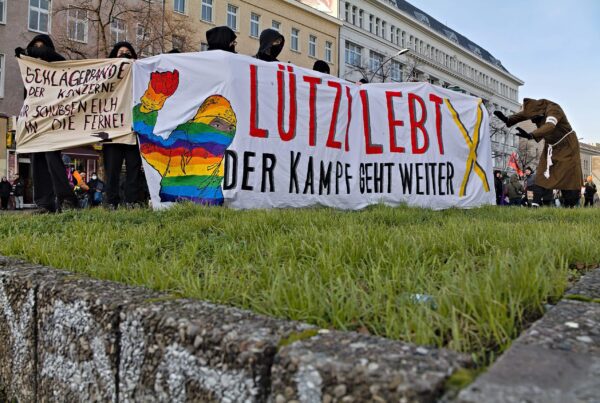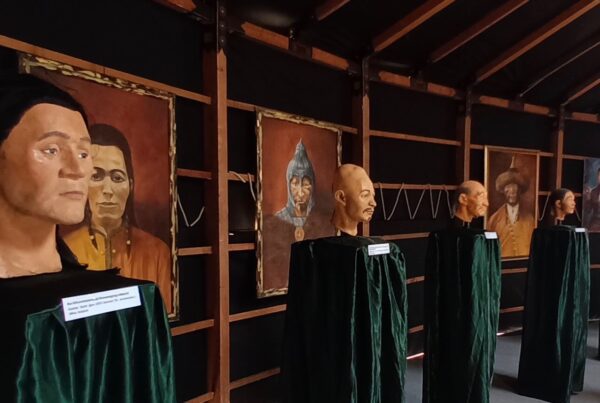Germany has a long history of colonialism and racism in Eastern Europe. To this day, people who are perceived as “Eastern” face discrimination and exclusion. In research and in current anti-racist debates, however, their experiences largely represent a blind spot. At the same time, the topic is instrumentalized by the Russian state—and the networks and influencers supporting it—as “Russophobia.” To avoid leaving the topic open to ideological instrumentalization, it is vital to talk about anti-Eastern European and anti-Slavic racism.
In Western thought since the Enlightenment, “Eastern Europe” has been seen as the “other” in the sense of “Europe but not Europe” (Larry Wolff). The term has denoted a world between Occident and Orient that is characterized by backwardness and barbarism. Maria Todorova has outlined similar findings regarding Southeastern Europe, or “the Balkans.” Such a perspective can be described as colonial and as anti-Eastern European racism, defined as a set of pejorative, essentialist ascriptions to the geographical space of Eastern Europe and its inhabitants. This is particularly evident in Germany because of its long history of interdependence with and expansion into Eastern Europe.
A hierarchizing view on “the East” was a constant of German discourse in the “long” nineteenth century. A prominent example is the deeply colonial discourse in the debates in the Frankfurt Paulskirche in 1848/49: Starting from the question of the position of Posen and Bohemia in a future German Empire, a large, cross-factional majority debated a much more far-reaching “German East” reaching to the Black Sea, which was to be conquered and dominated in a mission civilisatrice. Another example is Gustav Freytag’s influential novel “Soll und Haben” (1855), which featured on the bookshelves of almost every upper-bourgeois household for decades and anchored both anti-Semitic images and the indelible stereotype of incompetent Poles in the collective consciousness.
The German Empire brought about a radicalization and racialization of the German view on “the East.” In the pseudo-scientific racist discourse that developed from the second half of the nineteenth century, the “Slavs” in particular were constructed as a separate “race” whose “whiteness” was not in question, but who were nevertheless inferior. Racism against people from Eastern Europe is therefore often referred to as anti-Slavic racism or anti-Slavism. This anti-Slavism had practical consequences: The German Empire established group-based discriminatory policies regarding residency opportunities and naturalization options for immigrants from Eastern Europe, thereby allowing anti-Slavic and anti-(Eastern) Jewish resentments to mix and reinforce each other. The German Empire’s settlement policy in the Polish partition territories of Prussia (“Ostmark”) belongs to this continuity, as does the “Land Ober Ost” of World War I and the “Grenzkolonialismus” (border colonialism) and “Grenzlandarbeit” (borderland work) that were propagated in the Weimar period. Furthermore, the emergence of “Ostforschung,” which provided scientific expertise for colonization plans (“Deutscher Osten”), has significant importance in this context. The rise of anti-Slavism occurred concurrently with other forms of discrimination against inhabitants of the greater region, such as anti-Semitism (“Eastern Jews and Jewish Bolshevism,” portrayed as enemies) and antiziganism. This historical as well as contemporary intersectionality of anti-Slavism has hardly been researched so far, although it is increasingly being addressed by representatives of the young post-East (PostOst) generation in Germany (Prokopkin 2022; Tikhomirova 2022; quarteera 2022).
The Nazi regime’s “Generalplan Ost” and its extremely brutal rule in the occupied territories of Eastern Europe represented the culmination of such racist hierarchizations and expansionist projects. Along with the Jewish population, which was murdered in the Shoah, the Slavic population was assigned the role of racially inferior enslaved people (“slawische Untermenschen”— “Slavic subhumans”). The large number of victims among the civilian population in the Soviet Union, Poland, and South-Eastern Europe can be understood only in light of this racist background. One need only recall the blockade of Leningrad, which still receives little attention in Germany: Over a million people starved and froze to death in the city because, in the view of the Germans, they were “superfluous eaters” who were to make way for “Germanization.” Another example is the treatment of the millions of so-called “Eastern workers” (“Ostarbeiter”) who performed forced labor in the German Reich under inhumane conditions. Their separate marking with the patch “Ost” and the prohibition against them having sexual relations with the “Aryan” population can only be described as racist.
So far, the story is relatively well known. However, its relevance to the period after 1945 is rarely discussed. We have known for a long time that there was no “zero hour”—and this is no less true of anti-Slavic and anti-Eastern European racism. In the Cold War period and beyond, anti-communism directed at Eastern Europe, swear words, and jokes about Eastern European immigrants (which experienced a renewed boom, especially after 1989) represent continuities. In the post-socialist period, large numbers of ethnic German repatriates (Spätaussiedler) and contingent refugees came to Germany as “special” migrant groups whose membership was negotiated against the background of their “Eastern” origins. Like so many people perceived as “Eastern,” they experienced professional de-skilling and found—and still find—themselves far down the German work hierarchy, employed in warehouse logistics, in care work or as cleaners. They experienced discrimination because of their accents, their surnames, or because the food they ate at home was different;. They share these experiences of devaluation with other migrant groups and people in the Federal Republic, such that it would be only logical and appropriate to think about and recognize them together. The 2019 micro-census estimates that around 10 million people in the Federal Republic have a migration background from Eastern Europe, including the states that have acceded to the EU since 2004, the former Soviet Union, and the former Yugoslavia. Thus, one-eighth of the total population of Germany—and nearly half of Germany’s 21.2 million residents with a migration background—come from Eastern Europe. Identifying the discrimination against these people is fundamental to make all forms of racism visible in German society.
Marginalization of “the East” and the Question of “Whiteness”
Despite the great historical and contemporary importance of the topic, it received only limited attention both in research and in public debate. In part, this is due to the public’s generally limited knowledge about Eastern Europe in general: the “Global East” has, since at least the end of the Cold War, held the status of a “semi-periphery,” leading to its “dual exclusion,” since it is regarded as “not-quite-North” and at the same time “not-quite-South.” This marginalization of “the East” is reinforced by the fact that people in or from Eastern Europe have not been able to find their place in the current discourse on racism and postcolonialism, with the consequence that their experiences go almost unnoticed. If we understand critical whiteness as “a system of power relationships” based on “marked racialised identities,” then Eastern Europeans are still generally regarded as “white but not quite,” as “off-white blacks.” This is especially true for the (late) repatriates who are “privileged” in the German migration regime, as they were granted German citizenship and were able to take advantage of various support measures. However, as described, this did not protect them from falling victim to racist hostility and violence. How does their position as “internal others” impact their (non)positioning in debates around (post)colonialism and (anti)racism? Moreover, what does this imply for future inclusive conceptualizations of racism? So far, the transnational reception of contemporary theories on racism and Critical Whiteness leaves blind spots in the group-based discourses that underlie German history and present-day life. They pose the risk of excluding people who do not fall into the “black” and “white” dichotomy but who nonetheless suffer racial discrimination. Eastern Europeans’ experiences in Germany are an illustrative example of this. They are not racially discriminated because they are “white,” but because other racist hierarchizations affect “white” people. Racism it is, nonetheless.
In addition, there is often a lack of awareness of ambiguity. People in and from Eastern Europe can be racist and still suffer it themselves. It is precisely the dynamic between suffering and practicing racist discrimination in hierarchically organized, diverse societies that needs to be understood: The path to acceptance in the dominant society may lead through one’s own racist practice. The anti-racist and postcolonial debate, on the other hand, is often dominated by a rigid perpetrator-victim dichotomy. People and societies can, however, be both at the same time. A current example of this is Russia—which brings us to the question of developments since February 24, 2022.
Hostility and Instrumentalization
Russia’s war of aggression against Ukraine, which began in 2014 and was extended on February 24, 2022, has brought increased attention to the issue of racism against people from Eastern Europe. Domestically, since the war began, there has been an accumulation of incidents in which Russian-speakers in Germany have collectively been blamed for the war in Ukraine. These acts have ranged from online calls for boycotts of actual or perceived Russian restaurants and stores, to insults, to an alleged arson attack on the Lomonosov School in Berlin on March 11, 2022 (though it remains unclear who was behind the act). Such actions must be clearly condemned, as they are used to attack and blame large groups of people—most of whom have lived in Germany for years or decades and who are not responsible for Russia’s criminal war. Moreover, many of the people attacked are not from Russia in the first place: the around 3.5 million post-Soviet migrants in Germany come from diverse countries of the former Soviet Union and are usually multilingual. Their lingua franca is Russian, but its use says nothing about whether someone sees him- or herself as “Russian” or even as a supporter of Putin. These attacks therefore show that racism is based on external attributions that do not necessarily correspond to the self-image of the people concerned. This is particularly bitter for those people who come from Ukraine and are currently fearing for the lives of their relatives and friends there, yet are addressed and attacked as “Russian.”
For their part, the Russian state and pro-Putin networks and influencers have engaged in targeted instrumentalization of these cases. Both the nationalist pro-Putin car parades in several German cities and the homepage of the Russian embassy in Germany foster the impression that all Russian-speaking people in Germany are being discriminated against. The catchword for this is “Russophobia,” the implication being that enmity against everything Russian is determining the actions of “the West.” Both President Putin and Foreign Minister Lavrov have repeatedly made this accusation—even before the attack on Ukraine, but especially afterwards—in order to delegitimize the sanctions against Russia and the military support for Ukraine. These views are likewise propagated by influential influencers such as Alina Lipp, who has more than 180,000 followers on her Telegram channel “News from Russia” (Neues aus Russland). In mid-March, she shared a video there about the alleged murder of a 16-year-old Russian-German who had been beaten to death by a “mob of Ukrainian refugees” in Euskirchen. The case very quickly proved to be Russian fake news, but went viral in a very short time regardless. It is a prominent example of the online activities of pro-Russian activists and the instrumentalization of the issue of racism. The buzzword “Russophobia” is used in an attempt to silence voices critical of Russia’s war in Ukraine and to divide Western European societies.
Another way in which Germany’s colonial history in Eastern Europe is still apparent is the strikingly low level of knowledge about Ukraine. It is a specifically German tradition to look only at Russia when looking “towards the East,” as if the entire imperial and Soviet history was a purely Russian one. There is a clear lack of recognition of the autonomy of the countries “in between” and respect for the interests of their inhabitants. Both Ukraine and Belarus long represented terra incognita in the German debate: nothing was known about these two countries and they were condescendingly seen as supposed Russian zones of influence. Russia’s war of aggression has, at least temporarily, led to a change in this image. Solidarity with refugees from Ukraine is great and hundreds of thousands demonstrated in support of Ukraine in the first weeks of the war (albeit with sometimes clearly divergent demands). It remains to be seen whether this change will survive the shock effect of war or whether, in view of the worsening economic and energy situation, compromise with Moscow at the expense of a country “in between” will soon be the order of the day again.
Eastern Europe Matters
Anti-Eastern European and anti-Slavic racism is historically, as well as currently, of central importance. The current attempts to instrumentalize it do not speak against its thematization, but rather for an increased need for science-based information in order to avoid ceding the field to propaganda and fake news. This also requires an opening of the anti-racist and postcolonial debate: A historically adequate and non-exclusionary approach to the topic of “racism” would have to overcome essentialisms and dichotomies and establish a consensus that it should not be about memory or victim competition. Different racist categories and practices, with their specific characteristics, must be analyzed. Racism against people from Eastern Europe, in particular, must be taken very seriously—it is a “racism against whites” that affects people not because they are “white”, but because other racist hierarchizations affect outwardly “white” people. Looking at the after-effects of the colonial heritage in Eastern Europe, an “eastward expansion of memory”—and thus also of the racism debate—is overdue and urgently needed.







